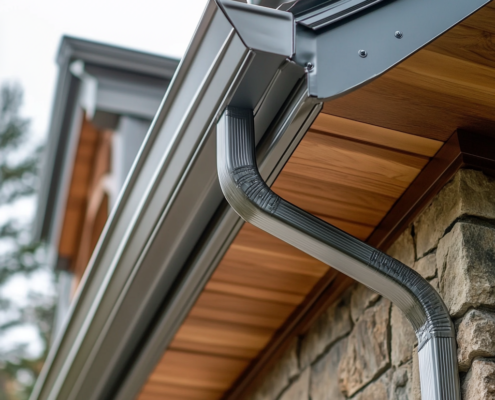Why Aluminum Eavestroughs are a Top Choice for Homeowners
Aluminum eavestroughs, also known as gutters, are a valuable addition to any home, enhancing curb appeal while effectively managing rainwater. Lightweight, durable, and available in various colors, aluminum eavestroughs provide an affordable way to protect your home’s foundation, landscaping, and exterior from water damage. In this guide, we’ll explore the step-by-step process of installing aluminum eavestroughs, along with essential tips to ensure a long-lasting, efficient drainage system for your home.
Benefits of Aluminum Eavestroughs: Why Choose Aluminum?
Aluminum eavestroughs offer a unique combination of durability, low maintenance, and aesthetic flexibility:
- Durable and Lightweight: Aluminum is resistant to rust and corrosion, making it suitable for all weather conditions. It’s also lighter than other materials, which simplifies installation.
- Cost-Effective: Aluminum gutters are more affordable than copper or steel, providing a reliable option without breaking the bank.
- Aesthetic Appeal: Available in various colors and profiles, aluminum eavestroughs can be customized to match any home style, increasing curb appeal.
- Easy to Maintain: Aluminum gutters require minimal maintenance and can last up to 20-30 years with proper care.
Essential Steps for Installing Aluminum Eavestroughs
1. Choosing the Right Materials and Supplies
To ensure a successful installation, select the appropriate materials, tools, and fasteners:
- Quality Aluminum: Choose high-grade aluminum for durability, and verify the thickness (gauge) for your climate.
- Self-Drilling Screws or Galvanized Nails: These fasteners are designed to prevent rust and provide a secure hold for aluminum.
- Accessories: Downspouts, hangers, and end caps are essential components for completing your eavestrough system.
- Sealant: Waterproof sealant helps prevent leaks and keeps the system watertight.
Selecting compatible materials from a single supplier helps simplify installation and ensures that parts fit correctly.
2. Preparing the Installation Area
Preparation is key to a successful installation:
- Measure the Area: Use a tape measure to determine the length and pitch of your roof to ensure proper drainage.
- Check for Hazards: Clear any debris, identify potential hazards, and use proper safety equipment like a ladder stabilizer.
- Mark the Slope: Aluminum eavestroughs need a slope of approximately 1/4 inch per 10 feet for optimal water flow.
3. Installing the Aluminum Eavestroughs
When you’re ready to install, follow these steps:
- Start at the Downspout Location: Attach the first section near the downspout. This will serve as the reference point for leveling the eavestrough.
- Install Section by Section: Work your way along the roofline, leveling and securing each section with brackets. Secure the brackets to the fascia with galvanized nails or self-drilling screws for stability.
- Seal the Joints: Apply a waterproof sealant to each joint, ensuring that water doesn’t leak through the seams.
4. Connecting Sections and Ensuring Proper Level
Connecting sections securely ensures efficient water flow:
- Align and Connect: Join sections of eavestroughs using connectors, ensuring they are level and properly aligned.
- Seal Corners and Joints: Add an extra layer of sealant around corners to prevent potential leaks.
- Check for Leaks: Once the sections are connected, test for leaks by pouring water through the system.
5. Attaching Downspouts
Downspouts guide water away from the roof and foundation:
- Location and Position: Attach downspouts to the lowest point of the eavestroughs, spacing them about every 30-40 feet.
- Secure with Brackets: Use two brackets per downspout to ensure stability, and caulk around the base for added water resistance.
- Direct Water Away: Position downspouts to channel water away from the foundation, which helps prevent erosion and water damage.
Maintenance Tips to Extend the Life of Aluminum Eavestroughs
Regular maintenance prevents clogs, leaks, and water damage:
- Clean Twice a Year: Remove debris, leaves, and dirt from eavestroughs in spring and fall.
- Inspect for Damage: Check for loose fasteners, rust, and leaks. Repair or replace damaged sections as needed.
- Use Gutter Guards: Install gutter guards to reduce debris buildup and minimize maintenance.
Frequently Asked Questions About Aluminum Eavestroughs
Are Aluminum Eavestroughs Easy to Install?
Yes, aluminum eavestroughs are popular for their lightweight and easy-to-install nature. With the proper tools and safety equipment, DIYers with basic skills can handle this project.
How Much Do Aluminum Eavestroughs Cost?
On average, aluminum eavestroughs cost between $4 to $9 per linear foot, depending on factors like thickness, color, and brand. Installation by a professional typically costs more, but DIY installation reduces expenses.
Can I Install Aluminum Eavestroughs Over Existing Gutters?
While it’s possible, it’s not recommended. Removing old gutters ensures a stable, clean surface for the new installation, reducing the risk of alignment issues.








